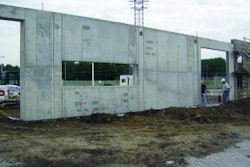
Delivering on President Obama's promise to boost the labor movement, the administration has announced a $35 million federal construction project in New Hampshire that requires union representation for the workers and forces nonunion employees to pay dues and contribute to a union pension fund.
Mr. Obama issued an executive order in the first weeks of his presidency that would make the requirement, known as a "project labor agreement" or PLA, the norm for all government contracts on large-scale construction jobs. The order is under review and a final rule is not expected for months, but that did not stop the Labor Department from rushing to use a PLA to build its new Job Corps Center in Manchester, N.H.
The PLA executive order replaced a Bush administration order that discouraged the use of such agreements.
It was one in a series of early policy moves by Mr. Obama that has dramatically improved the unions' fortunes, though the president has not delivered on labor's top legislative priority, the so-called "card-check" bill that would make it easier to organize workplaces.
Critics say imposing the union-friendly rules on the New Hampshire job - the first federal construction contract with such stipulations since President Clinton was in office - will drive up costs, delay the project and force most of the workers to pay union dues and pension contributions for which they likely will never receive benefits.
North Branch Construction, a Concord, N.H.-based general contractor and member of the business group Associated Builders and Contractors (ABC), filed a bid protest this week with the Government Accountability Office, claiming the PLA "unduly restricts competition."
"PLAs are special-interest handouts that deny taxpayers the accountability they deserve from government contracts," said Ken Holmes, president of North Branch Construction.
Sen. Judd Gregg, New Hampshire Republican, said the scarcity of local unionized workers and a separate requirement that contractors must have completed three previous successful PLA projects to qualify to bid will essentially prevent local firms from competing for the Manchester project.
"The administration's decision to discriminate against successful and independent construction firms simply because New Hampshire employees choose to work in a union-free workplace and not bow down to the demands of Big Labor is extremely unfair to our state," the senator said, calling on the administration to revoke the PLA.
"In a time of economic hardship, it is simply absurd to discriminate against local contractors and construction workers for the benefit of national labor unions," he added.
Union officials argue that PLAs, which incorporate collective bargaining agreements into the contract, ensure the construction companies hire highly skilled workers and pay them fair wages.
"Rather than all the money going to the contractor profit, a fair share goes into the worker's paycheck," said Greg Denier, communications director for Change to Win, a coalition of unions that includes the Laborers' International Union of North America.
Brett McMahon, vice president of business development for Miller & Long Co. Inc., the country's largest concrete subcontractor and the largest employer of construction workers in the Mid-Atlantic region, argued that it was the unions that are exploiting the workers.
"In order to go to work, you have to pay for it," Mr. McMahon said.
He said that unless the workers join a union, they would not be expected to accumulate enough consecutive hours on union jobs to become vested in the pension plan. The money paid into the plan would then be forfeited to the fund.
He also noted that the economic recession has left few large-scale construction jobs other than federal projects, and that most construction workers are not union members. As a result, he said, the PLA forces nonunion workers desperate for jobs to choose between joining the union or forfeiting any payments to the unions.
Tom Owens, spokesman for the AFL-CIO's Building and Construction Trades Department, said the money paid into union pension funds can be used only to benefit workers. He also said pension contributions do not come out of workers' paychecks.
"It comes from the contractor," he said.
He said Miller & Long is the perfect example of why PLAs are necessary. He said the company has a history of assembling the most inexpensive work force it can find, relying mostly on illegal immigrants - a practice, he said, that had suppressed wages and forced black workers out of the construction industry.
Mr. McMahon called the union's accusations a "tired old refrain" that has no bearing on the PLA issue.
"You don't stay in business 60 years by doing that," he said.
He also challenged the AFL-CIO's characterization of the pension contribution, saying that payment into the union fund is calculated as part of a worker's total compensation package.
About 16 percent of the country's construction trades workers were union members or covered by union contracts in 2008, despite union workers generally receiving higher pay and better benefits than their nonunion counterparts, according to the Bureau of Labor Statistics.
In New Hampshire, just 8.7 percent of construction workers are unionized.

















